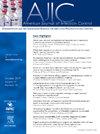人工智能(AI)用于医疗保健领域的个人防护装备培训、修复和教育。
IF 3.8
3区 医学
Q2 INFECTIOUS DISEASES
引用次数: 0
摘要
背景:个人防护装备(PPE)是一种基于传播的一线预防措施,可减少医院感染在医护人员、患者和工作人员之间的传播。在2019冠状病毒病大流行期间,卫生保健工作者的医院感染率过高,突显了有效穿戴/脱下个人防护装备方面存在的技能差距问题。方法:我们对澳大利亚悉尼的293名医护人员进行了一项单中心、混合方法、前瞻性队列研究。参与者使用SXR AI-PPE®进行评估,这是一种人工智能系统,可自动评估PPE的穿/脱,同时提供用户技术的实时反馈。记录了人工智能引导和非引导会话的用户性能的定量数据,包括准确率(%)、脱/脱时间(秒)和多次尝试的性能。此外,在培训前后进行问卷调查,以评估使用者正确使用个人防护装备的自我效能感的变化。结果:纵向结果显示,每隔3个月进行一次指导课程后,正确穿/脱PPE的准确率有所提高,两次指导课程后正确使用PPE的准确率为100%。经过AI-PPE培训,穿上和脱下所需的时间分别减少了15秒和22秒。这些改进通过3个月的培训课程得以保持。结论:SXR AI-PPE®平台是一个综合性的工具,能够对医护人员进行实时的PPE穿脱培训。AI-PPE平台可以有效提高穿戴/脱衣技能和自我效能感,对减少PPE污染和医院感染风险具有重要意义。本文章由计算机程序翻译,如有差异,请以英文原文为准。
Artificial intelligence (AI) use for personal protective equipment training, remediation, and education in health care
Background
Personal protective equipment (PPE) is a first-line transmission-based precaution for reducing the spread of nosocomial infections between health care workers (HCWs), patients, and staff. The COVID-19 pandemic highlighted a problematic skill gap in effective PPE donning/doffing.
Methods
We performed a single-center, mixed-methods, prospective cohort study of 293 HCWs in Sydney, Australia. Participants were assessed using SXR AI-PPE, an artificial intelligence (AI) system that autonomously evaluates donning/doffing of PPE while providing real-time feedback on user technique.
Results
Longitudinal results showed improved accuracy rates for correct donning/doffing after each guided session conducted at 3-monthly intervals, with a 100% accuracy rate for correct use of PPE after 2 guided sessions. These improvements were maintained with 3-monthly training sessions.
Conclusions
The SXR AI-PPE platform is a comprehensive tool capable of training PPE donning/doffing by HCWs in real time with implications for reducing PPE contamination and risk of nosocomial infections.
求助全文
通过发布文献求助,成功后即可免费获取论文全文。
去求助
来源期刊
CiteScore
7.40
自引率
4.10%
发文量
479
审稿时长
24 days
期刊介绍:
AJIC covers key topics and issues in infection control and epidemiology. Infection control professionals, including physicians, nurses, and epidemiologists, rely on AJIC for peer-reviewed articles covering clinical topics as well as original research. As the official publication of the Association for Professionals in Infection Control and Epidemiology (APIC)

 求助内容:
求助内容: 应助结果提醒方式:
应助结果提醒方式:


